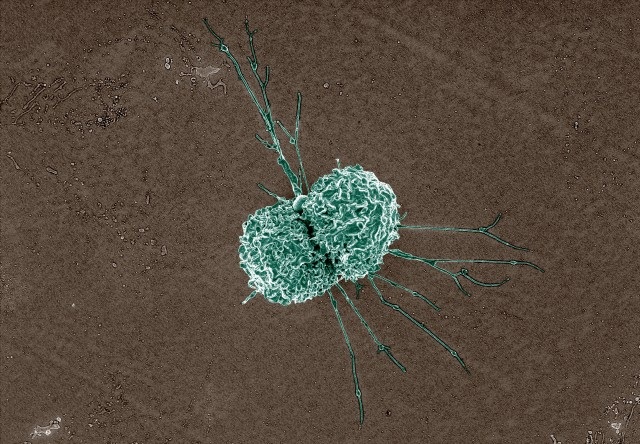Los Macrófagos asociados al tumor TAM, se comportan como reguladores de la tumorogénesis, bien sea como residentes o como derivados de la médula ósea o bazo.
Los macrófagos son considerados clásicamente como células efectoras durante la defensa inmune, sin embargo numerosos estudios han demostrado su papel en la progresión tumoral .
Estos macrófagos son una fuente importante de proteasas, como la cisteína y la catepsina, que participan en la progresión tumoral . Los TAM presentan funciones antagónicas entre la homeostasis del tejido normal y la tumorogénesis, razón por la cual los macrófagos son funcionalmente plásticos y pueden alterar su fenotipo para adaptarse a diferentes condiciones fisiológicas .
*************************************
Revista Nature , Octubre 2016 .
B Cells and Macrophages pursue a common path toward the Development and Progression of Chronic Lymphocytic Leukemia .
 G Galletti , F Caligaris-Cappio and M T S Bertilaccio .
G Galletti , F Caligaris-Cappio and M T S Bertilaccio .* Department of Experimental Therapeutics, The University of Texas MD Anderson Cancer Center, Houston, Texas, USA .
* Division of Experimental Oncology, IRCCS San Raffaele Scientific Institute, Milan, Italy .
* Vita-Salute San Raffaele University, Milan, Italy .
The development and progression of chronic B-cell tumors depend on a complex microenvironmental network of cells that include monocyte-derived macrophages. In chronic lymphocytic leukemia (CLL) the survival of malignant cells is supported in vitro by nurse-like cells (NLCs) which differentiate from CD14+ monocytes and have been identified as tumor associated macrophages (TAMs).
The role of the monocyte/macrophage lineage in CLL has been extensively studied in vitro but only recently has been investigated in in vivo models. We here discuss how the cellular and molecular interactions that physiologically occur between B cells and macrophages can be subverted in chronic B lymphoid malignancies. Clinical approaches for the therapeutic targeting of TAMs are under evaluation.
Promising strategies, along with a direct impact on the malignant cells, affect crucial pathways involved in the interaction of leukemic cells with TAMs. As an example, ibrutinib reduces CLL cell chemoattraction by inhibiting macrophage secretion of CXCL13.
Lenalidomide and trabectedin prevent TAM recruitment mainly through CCL2 blockade.
Most advanced strategies aim at depleting macrophages by targeting the CSF1/CSF1R pathway which is fundamental for TAM survival. Of note, CSF1 transcripts are significantly more abundant in progressive CLL patients when compared with stable CLL and the frequency of CSF1R+ TAMs correlates with poor survival in hematological malignancies.
The successful combination of CSF1R inhibition with currently available agents targeting malignant cells might represent the next therapeutic frontier in CLL.
Conceivably these approaches may become applicable to numerous chronic B lymphoid malignancies.
